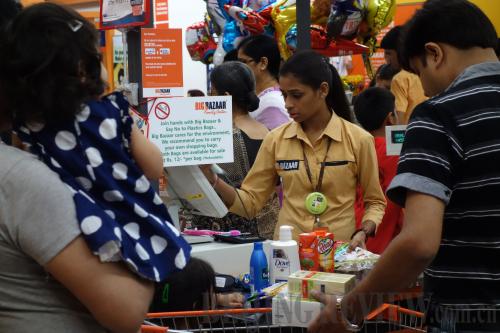|
 |
|
RETAIL REFORM: Shoppers browse goods at a supermarket in New Delhi on September 15, 2012. Indian launched a new round of economic reforms that month, seeking to further open up its economy to foreign investment (LI YIGANG) |

The pace and nature of India's economic reforms have brought a degree of anxiety among investors, the World Bank's Chief Economist for South Asia Martin Rama said at a press event in April. But one week later, Indian Finance Minister Palaniappan Chidambaram reiterated India's commitment to the reforms, stating that the Indian Government will take more executive actions to guide the process in the next two to four months. He also expressed hopes that economic growth will increase from last fiscal year's 5 percent to 6.1-6.7 percent this fiscal year.
These opposing views have aroused debate on the prospects of the economic reforms. In fact, the latest reforms, launched in September 2012 and hyped as being on the level of the 1991 reforms, have run into major political obstacles because of a lack of consensus among India's political forces.
Major changes
India's economy took a downturn in the latter half of 2011 as growth began to slow and its fiscal deficit and inflation rose, dragged down by the poor economic performance of Europe and the United States. The once promising Indian economy faded gradually. Many in the Western media, which had placed high hopes on the emerging economy, were forced to abandon their expectations of an "Indian miracle."
To reverse the economy's malaise ahead of the 2014 general election, Indian Prime Minister Manmohan Singh launched bold economic reforms. He appointed as finance minister the reformist Chidambaram, who has close relations with the Indian business circle, and together they unveiled a series of economic reform packages to open up the Indian economy, speed up infrastructure construction and rein in the fiscal deficit.
India has long pursued a moderate economic liberalization policy since its independence. Even after the 1991 economic reforms, the degree of opening up in India's economy has remained low. For example, large foreign retailers such as Carrefour and Tesco, which are found in almost every big city in China, are still rare in India. A U.S. government report, quoted on April 13 by the Indian newspaper Business Standard, said the United States is dissatisfied with India's practice of barring foreign investments in sectors such as insurance, banking, communications and postal services. Evidently, India's problem with opening up its market is a prime reason why private capital at home and abroad is not being invested in India.
In light of this, the Indian Government has announced it will increase the proportion of foreign capital in aviation, retail and communications industries. The highest proportion of foreign capital in the three sectors can be up to 49 percent, 51 percent and 74 percent respectively. New Delhi has also decided to allow foreign capital to invest in insurance and pension sectors, with the upper limit of foreign equity at 49 percent. In addition, the Indian Government is now negotiating with its central bank and the Bombay Stock Exchange to increase the quota on foreign investment in government and corporate bonds.
The underdeveloped infrastructure of India has long been a topic of complaint, with the 2012 summer blackout delivering another blow to the nation's image. Singh said frankly that the crumbling infrastructure, weather-dependent agriculture and skilled labor deficiency in manufacturing are the three bottlenecks for India's economic development. The Indian Government has come to realize that the service industry-driven economic mode cannot solve employment problems, nor can India's economy achieve its full potential under this pattern. Moreover, it remains far behind its goal of "inclusive growth."
In recent years, the Indian Government has given priority to infrastructure construction and manufacturing. It has planned to invest $100 million in infrastructure construction from 2012-17 and unveiled an ambitious manufacturing development scheme. However, little progress has been made thus far. Therefore, the Indian Government hopes to inject impetus to these sectors by dint of economic reforms, trying to pursue a more balanced and sustainable development mode. In December 2012, the Indian cabinet decided to set up a new Cabinet Committee on Investment headed by the prime minister. The committee will monitor and appraise the implementation of big projects, ensuring their timely approval. In the meantime, India's Insurance Regulatory and Development Authority would consider making new investment plans to funnel more insurance funds to infrastructure projects.
|
